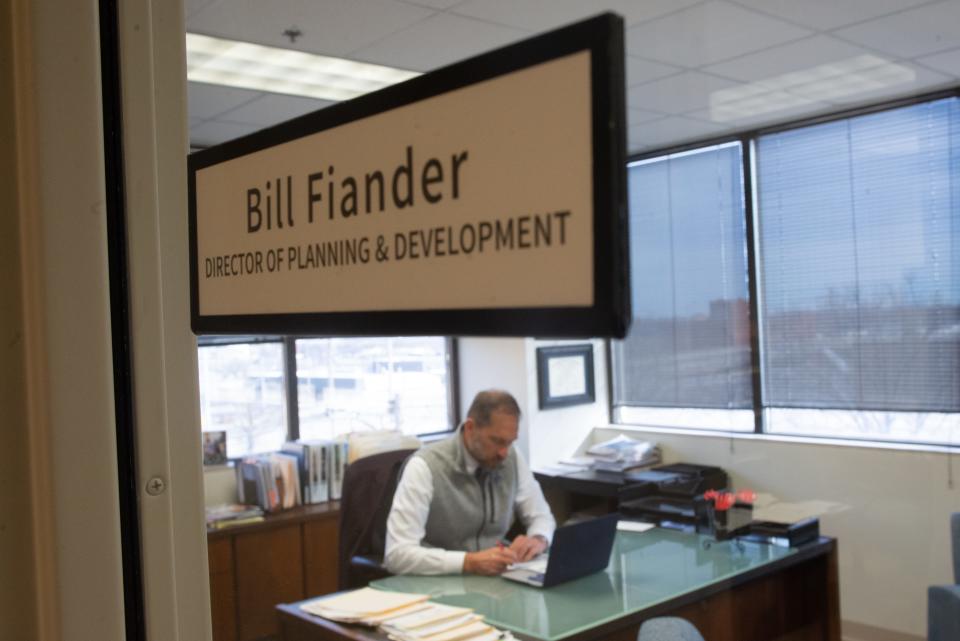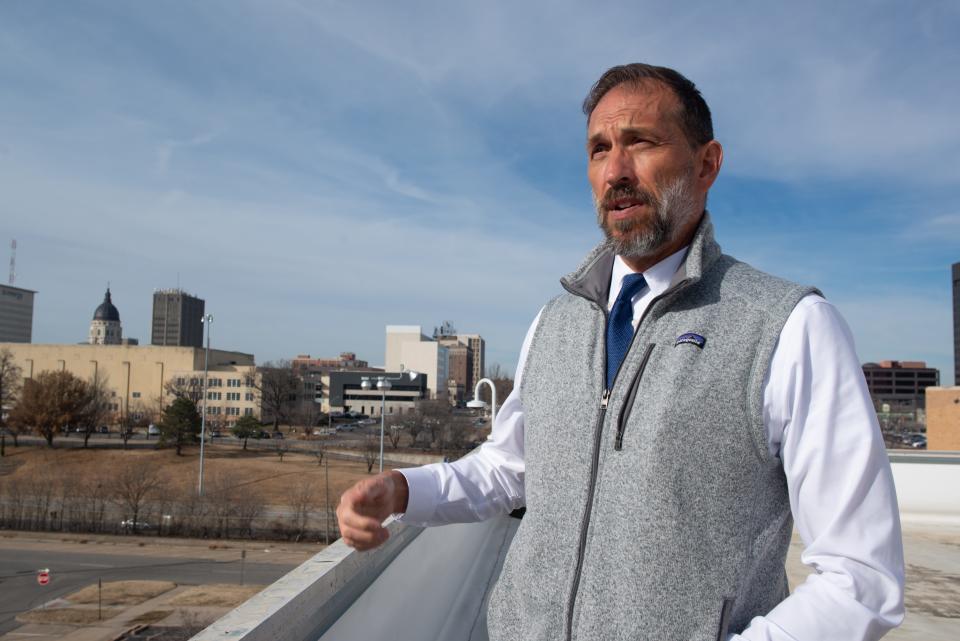Bill Fiander came to Topeka with a 2-year plan; 26 years later, here's what makes him proud

Bill Fiander went above and beyond the call of duty by attending the 2002 funeral for Emogene Shepard, president of the Tennessee Town Neighborhood Improvement Association, said her grandson, Michael Bell.
As an employee of the city of Topeka's planning department, Fiander had worked with Shepard and shared her commitment to making a better place out of the violence-plagued central Topeka neighborhood where she lived.
After Shepard died at age 86, Fiander shared words of comfort with Bell at her funeral that "helped me to get through," Bell recalled this past week.
"He said to me, 'It is because of people like your grandmother that we do what we do,'" Bell said.
'The noblest motive is the public good'
Tennessee Town benefited from Fiander's considerable skills and education, as well as his willingness to connect with residents on a personal level while realizing he was "helping living, breathing people," Bell said.
Fiander's last day with the city was Friday. He retired at age 57 as director of planning and development to take a job teaching political science at Washburn University, where he already worked part-time as an adjunct professor.
Fiander told The Capital-Journal about how — in a quote borrowed from the Roman poet Virgil — he tells his students, "The noblest motive is the public good."
Fiander genuinely wants his pupils to feel that way, and to realize that pursuing a career in municipal planning is one of the best ways to achieve the public good, he said.
Fiander hoped to 'save' Johnstown

Fiander intended to only stay in Topeka about two years when he started work in 1997 with the city's planning department, he said.
At that point, Fiander said, he still dreamed of going back to "save" his hometown, Johnstown, Pennsylvania, a gritty, working class community where he lived until he moved with his family as a high school freshman to southern California.
Johnstown was the site of a flood that killed more than 2,200 people in 1889 but went on to become a successful working class community featuring steel mills, coal mines and railroads.
About two years after Fiander's family moved to Westlake Village in Los Angeles County in southern California, he said, Johnstown was devastated by the collapse of the steel industry, which caused unemployment there to soar.
'They never let it go'
Fiander attended and graduated from Stanford University in Stanford, California, where he played linebacker on the football team in the mid-1980s.
Probably 90% of his teammates in his freshman year were on the team that lost their Nov. 20, 1982, game to the University of California on what became known as "The Play," Fiander said.
At the time, Fiander was still a senior in high school.
After Stanford took a 20-19 lead that day on a field goal with four seconds left, California used five lateral passes to score a touchdown on the ensuing kickoff return to win, 25-20.
Thinking the play was over and their team had won, members of the Stanford Band came onto the field during the play, and the California player who scored the winning touchdown ran into a trombone player in the end zone.
Some of his Stanford teammates remained devastated by "The Play" for years afterward, Fiander said.
"They never let it go," he said.
Helping the inner city

Fiander said he wanted to be an architect. Stanford didn't offer a major in architecture, so he studied engineering, then economics, then earth sciences, with the latter introducing him to the field of urban planning.
Urban planners seek to promote the public welfare by designing and physically developing a community's land use and built environment — including air, water and the infrastructure passing into and out of urban areas, including transportation, communications and distribution networks.
As an urban planner, Fiander realized he had a passion for helping revitalize troubled inner-city neighborhoods.
After he graduated from Stanford, Fiander earned a master's degree in urban and regional planning from George Washington University in Washington, D.C., and worked as a planner in Ventura County, California, and Richmond, Virginia.
He took a job in 1997 as the first "neighborhood planner" for Topeka's city government, a job he said provided enticing challenges for a person in his line of work.
More:Menninger Clock Tower may have 'bona fide group' to acquire and repurpose iconic Topeka building
'I realized in the first few days that I could have a lot of impact here'
Topeka is an "old city, but not a rich one," Fiander said.
"It's perfect for a planner looking to engage in some inner-city revitalization," he said.
Topeka also offered opportunities for historic preservation and new growth, he said.
"It was big enough that you could get things done, but it wasn't too big," Fiander said. "I realized in the first few days that I could have a lot of impact here as a planner."
'How can we help?'
Bell recalled that when Fiander first came to the capital city, he asked Tennessee Town residents, "What would you like to do and how can we help?'"
Bell had never heard that before from a city official, he said, adding that what Fiander said should be the city's motto when it comes to serving its residents.
Bell and Fiander agreed on a number of different issues regarding planning and zoning, Bell said.
"We didn't see eye to eye on everything," he said. "But I always knew that his door was open, that he would listen, and that he would try to find compromise."
More:City planning director responds to councilman's comments
'Too much coincidence'
Fiander said his love for this community continued to grow the longer he stayed here, until he came to consider Topeka his new hometown.
Fiander found it particularly poignant when he learned that he and Topeka share the same birthday, Dec. 5, with Topeka having been founded on Dec. 5, 1854.
"That was too much coincidence when I found that out," he said. "I knew there was a reason I was supposed to be here."
Fiander was promoted to deputy planning director in 2003, interim planning director in 2012 and then planning director the following year. The department he supervised has 44 people, he said.
Topeka has had low self-esteem in the past
Fiander said he arrived pretty soon after moving here that the Topeka community had a self-esteem problem.
"That's the one neat thing about 25 years later, is I definitely see a difference in that self-esteem," he said. "I'm not saying the problem's not there anymore, but there's definitely been a palpable change in the way we look at ourselves, and that's really cool. We take so much more pride in this community."
Still, when he's away from Topeka, Fiander said, he encounters people with a poor perception of this community.
"It ruffles me when I hear that," he said. "They obviously don't know what I know."
Helping neighborhoods in need
Fiander feels particularly proud of the progress he's made helping Topeka's low-income communities.
The Topeka-Shawnee County Metropolitan Planning Department in 2000 produced the city's first Neighborhood Health Map, which uses color coding, statistical data and medical analogies to characterize the health of the city’s neighborhoods.
After the city in 2003 pulled out of the merged department, its planning department continued to create neighborhood health maps and use those to help determine priorities for planning and funding.
A study conducted last year showed that among the neighborhoods in need where the city has provided funding through its Stages of Resource Targeting, or SORT, program, 76% have seen improvements in their health scores, Fiander noted.
He said another big improvement he's seen involves Topeka's adoption of a "Complete Streets" concept aimed at making roadways safe for drivers, bicyclists, transit vehicles and users and pedestrians of all ages and abilities.
The city also has come to protect a considerably larger number of its historic properties through the creation of historic districts or neighborhood conservation districts, which Fiander described as being "historic districts light."
A passion for mentoring
Throughout his time here, Fiander said, he's considered it an important part of his job to "transmit knowledge to others."
Fiander feels a particular passion for teaching and mentoring the next generation, he said.
He recalled that he began working a couple years ago as an adjunct professor in Washburn's political science department, and really enjoyed it.
In his new job as a full-time faculty member in that department, Fiander said, he'll work to improve its public administration program.
Fiander said he's excited about sharing his experience as a municipal planning practitioner to encourage students to pursue that career path.
"The more I talk about it, the more I really don't feel like I'm leaving," he said. "I feel like I'm doing a lot of the same things, only on a different piece of property. I'll still be teaching about things that I love, and encouraging people to serve the public good."
Contact Tim Hrenchir at threnchiContact Tim Hrenchir at threnchir@gannett.com or 785-213-5934.
This article originally appeared on Topeka Capital-Journal: Bill Fiander retires as planning, development head for city of Topeka

